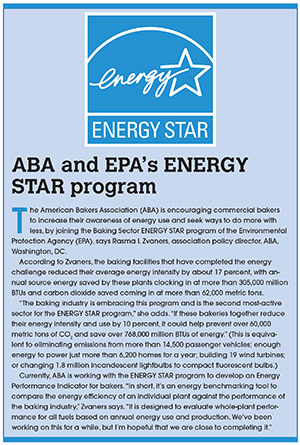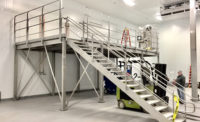Energy efficiency is vital to snack and bakery business success. Picture a typical bakery or snack plant, its numerous ovens, fryers and industrial refrigerators and freezers. Now add in elements common to any business, but on a large scale: lighting, heating, cooling, ventilation.
The result? “Large utility bills and a significant carbon footprint,” says Mike Anderson, sales manager, Air Management Technologies Inc., Lewisburg, PA.
The rumored carbon taxes are just the beginning of concerns for such businesses, and facilities that consider moves toward improved energy efficiency have a lot to gain. “Understanding and making efforts to reduce the amount of energy consumed should be on the radar of all businesses, as it has both social and economic impacts that can shape the communities in which they operate,” says Christopher Shepard, digital marketing manager and sustainable leader, ORBIS Corp., Oconomowoc, WI.
Obviously, lower energy consumption will translate to lower utility bills, but Shepard points out that facilities that reduce their energy also reduce the stress placed on their community’s electrical grid.
Nanci Tellam, group director of environmental services and sustainability at Ryder System Inc., Miami, cites many additional business-savvy reasons why companies should consider energy efficiency: government compliance, financial return on investment (ROI), improved investor or consumer relations, employee retention, increased supply-chain efficiency and developing an image as a “good, sustainable corporate citizen.”
Energy-savings solutions
To help snack producers and bakers reduce their energy consumption, industry partners are stepping up to offer solutions.
Environmental sustainability can often equate to economic sustainability. A spiral product conditioning system from Air Management Technologies operates with 10 to 30 percent of the energy cost of traditional refrigeration equipment, saving companies up to $50,000 annually and increasing food safety, says Anderson.
The company’s newest development is an absorption industrial heat pump that recycles otherwise discharged water from equipment such as cookers and kettles. “By lowering discharge water temperatures, facility water treatment is possible, permitting reuse in graywater applications,” Anderson adds. “The recovered heat energy is returned to facility processes, or may even be utilized to generate low-temperature refrigeration, further increasing returns and lowering facility carbon footprint.”
At Ryder, where transportation and logistics are everyday business, efficiency is king. The efficiency of its vehicles and buildings—those maintained by the company as well as those leased to customers—is enhanced with waste recycling programs, employee awareness and conservation programs, and energy-efficient lighting, as well as with a tracking, measuring and reporting system that culminates in a corporate sustainability report called the “Carbon Disclosure Project” (see www.ryder.com/about-us/sustainability/environmental-initiatives/carbon-disclosure-project)
Ryder’s warehouses reduce energy by assessing consumption, operations and material waste. Usage is monitored, and adjustments―like installing energy-efficient fans for air movement, retrofitting existing site lighting to fluorescent lighting, using skylights in warehouses, and adopting fast-charge battery technology to reduce charge time and electrical usage (and optimize labor)―are made. “We also participate in the U.S. Environmental Protection Agency SmartWay as a provider,” Tellam adds. “All of these programs provide the framework and foundation for Ryder to update our stakeholders on our results.”
Of course, downtime―which most manufacturers try to avoid in all aspects of their operations―is not just energy inefficient, it’s just plain inefficient for business. That’s why Ryder is proud of RydeSmart, a full-featured GPS tracking and vehicle performance system designed to cut downtime and increase operational efficiency. “RydeSmart serves as an early warning system that detects any issues in need of repair while the vehicle is on the road or in the shop,” explains Tellam. “The telematics system has the ability to assess any faults and directs the vehicle to the nearest shop location with the best capacity.” For technicians, this means they can better prepare for incoming vehicles before they arrive; for drivers, this means fewer onboard breakdowns since they’re alerted to potential problems in a timely manner.
Current challenges
Plant and operational efficiency is a worthy goal, but also a challenging one. “The biggest challenge is changing the procedures within an organization to encourage energy conservation,” says Shepard, noting that ORBIS reaps the rewards of its investments in motion-sensitive lighting, the use of skylights, recycling content and reducing water usage. It also helps customers make the most-efficient packaging decisions by comparing and evaluating reusable and single-use options, and presenting them with the energy usage, solid waste production and greenhouse gas emissions of each.
“Driving energy efficiency requires integration of standards and tools into the organization at all levels of the company,” agrees Tellam. How? By engaging employees as ambassadors to advance the strategy, she says. “This requires outreach, effective communication, metrics and benchmarking to drive best practices and behaviors and, most importantly, measurement and reporting. Developing the metrics and reporting tools that best serve your internal stakeholders can sometimes be a challenge, but it is key to a successful program.”
Another challenge is onboarding alternative energy sources—a practice Anderson notes has struggled to achieve a desirable ROI in recent years, in light of falling natural gas and electricity prices. “Instead, utilizing existing waste streams is becoming an increasingly popular source of process input energy and significant cost savings, and is frequently eligible for the same incentives,” he says.
The Sustainable Waste Heat Management System from Air Management Technologies recycles thermal waste streams from ovens, oxidizers and other sources that would otherwise be vented out. “In new facilities, our outdoor, mounted system frequently eliminates the need for steam boilers and their infrastructure, including a boiler room,” Anderson adds.
Indeed, thermal balancing―the process by which waste heat from one process provides input energy for another―not only generates energy savings, but also sets companies up well for future “zero energy” technologies later, Anderson says.
“Today, more and more customers are including sustainability criteria into their selection priorities, wanting to select partners who are driving the best sustainable solutions for the services they offer,” says Tellam. “Whether it’s an employee conservation program or improved maintenance program for high-energy equipment or fleets, there are savings benefits not only for implementing companies, but also for the customers they serve.”





